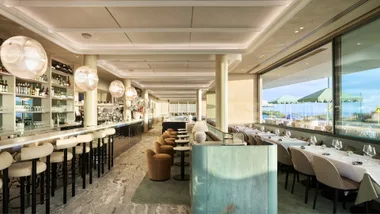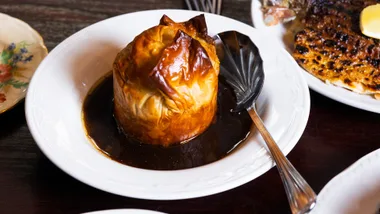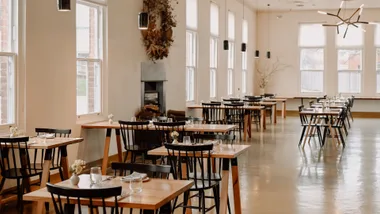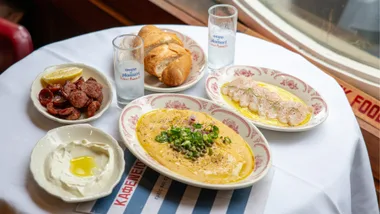Sydney Opera House, Bennelong Point, Sydney, (02) 9240 8000
Licensed
Cards AE, MC, V, EFT
Open Lunch Fri-Sun noon-2pm; pre-theatre daily from 5.30pm & 6pm; dinner daily 6.30pm-10pm
Prices Three courses $125; Cured & Cultured share plates $26-$30; desserts $28
Vegetarian One entrée, one main course, two bar plates
Noise Welcome buzz
Wheelchair access Yes (restaurant only)
Minus Not quite natural hospitality
Plus But a rousing new welcome to one of the world’s great buildings just the same
A friend rang me out of the blue the other day to ask me how I’d define Australian cuisine. “Bzzt!” I replied. “Shraffsh… breaking… up… shffsh… have to call you… shffsh,” and then promptly switched off my phone. But, of course, I could have just simply sent him to Bennelong.
I’d recommend it regardless of your interest in defining what “modern Australian” means. It’s a restaurant that has rocketed out of the gate in the face of very high expectations, and in most of the ways that count it has overshot the mark, bringing Sydney a new hybrid of casual and fine dining that’s utterly delicious.
That same friend from the phone is fond of quoting a line from an essay the Melbourne writer Arnold Zable wrote for an exhibition at the city’s Immigration Museum: “We are a nation of immigrants and indigenous people”. And fittingly for a restaurant named Bennelong, the menu here, in its small way, makes a gesture towards the Australian-grown and the indigenous without discounting the vital contributions of the nation’s newer arrivals. So you get grilled Lady Elliot Island bugs and red-claw yabbies, but the bugs come with fermented chilli and radishes, and the yabbies, like some bizarre (and bizarrely tasty) Devonshire tea, show up in the company of cultured cream, lemon jam and buckwheat pikelets tucked warm and jolly in a folded tea towel. You can, in short, have your shrimp and throw it on the barbie, too.
There was a bit of a tussle over the Sydney Opera House restaurant tender when Guillaume Brahimi decamped to Paddington after more than a decade’s successful trade. Rumours about who would take over the smallest sail of this splendid landmark, one of the highest-profile restaurant properties in the country, ran rife. It was going to be a grand Bills. It was going to be a Noma pop-up. It was going to be filled with jelly, then unmoulded and left to wobble in the midday sun. Justin Hemmes kicked the tyres, as did just about every other deep-pocketed operator in town. Then it looked very like it was going to be a Stokehouse. Then it wasn’t. And now it’s Bennelong again, only like it’s never been.
In defiance of sense, reason and the fact that they already have a rather well-regarded restaurant in sight of the House, the mob from Quay jumped into the breach. Peter Gilmore oversees both kitchens, but if running two of the biggest, most-drilled brigades in town is a strain, he is yet to show it. Plaudits, then, to Bennelong chef de cuisine Rob Cockerill and general manager Kylie Ball.
When Gilmore and John Fink, creative director of Quay’s parent company, the Fink Group, talked about their plans for the food at Bennelong ahead of its opening, they spoke about dishes that had similar qualities to those that put Gilmore on the map at Quay, but made simpler and with less fuss. “Fewer processes but still the same quality ingredients,”said Gilmore. The food at Bennelong is so good it may make you wonder what those additional processes and elements on the plate at Quay really add. The (relative) restraint of the new dishes is what makes them shine.
John Dory is seldom better than when it’s roasted on the bone, so that’s what Gilmore does here. He’s demurely lopped off the fish’s head, but it’s otherwise served whole, the meat beautifully set under a salty blanket of orach (aka fancy spinach), little drum-shaped pieces of turnip and kailan flowers. Somewhere there’s some “umami butter”, which I’m guessing involves seaweed, adding to the salty-savouriness of it all, but that’s all there is on the plate. And that’s all there needs to be. As part of the $125 three-course prix fixe set-up, the main courses are served with a side of mixed potatoes (selected perhaps more for prettiness than an ideal mix of tastes and textures) and a head of lettuce that some poor bugger has had to take apart, dress like a salad, then put back together again.
The other main courses mostly follow similar protein-and-three-veg lines: lamb, broad beans, Jerusalem artichokes, kale; suckling pig, cippolini onions, “heritage” apples, black garlic; beef, carrot and barley. The pig is from Macleay Valley, the beef is wagyu rump cap, the Flinders Island lamb is accompanied by anchovy salt and nasturtiums, though, and the precision and presentation are pure Peter Gilmore. Holmbrae duck, roasted to an almost Chinese-barbecue texture, has savour for days thanks in part to the addition of black miso, and finds an elegant foil in fronds of hispi cabbage, some raw, some pickled, interleaved with swatches of toasty nori.
Bracketing these are entrées and desserts that are every bit as accomplished as the main courses, and perhaps more notable in their inventiveness. The textural rhyme of wheat noodles – somewhere between udon and the lamian of northern China – and tender squid cut to the same shape makes eating them, with a dandan-like mixture of ground peanuts, sesame and smoked pork, a joy, while young garlic and translucent crisps of guanciale enliven a bowl of Tasmanian mussels served out of the shell with a salty broth and garnished sweetly with bean blossoms.
But fashioning a dessert that apes the shape of the Opera House is one of those ideas that probably should’ve been left at the brainstorming session. It’s a pavlova dome of raspberry and rhubarb piped all over with droplets of Italian meringue, like some latter-day Dolly Varden cake, adorned with crisp curves of meringue: Jørn Utzon meets Ken Done. And definitely more Done than Dane in the flavour stakes.
Contrast that with “crème caramel vs mille-feuille”. It’s a battle between the two desserts rendered in slivers of buttery pastry, artfully torn bits of the set custard, and bitter caramel in dollops and crisp wafers. To call it a mash-up is to do a disservice to both the art with which it has been plated to look so artless, and to a welcome flash of wit and levity in its conception.
It reads almost like Gilmore critiquing the geometric fussiness of his early Quay desserts, and eats like a dream. (Who won? I ask a waiter, the mille-feuille or the crème caramel? “I think it’s a draw, sir,” he replies. I demand a rematch.) It’s the dessert of the year.
The offer of three courses instead of a tasting menu feels really good. It’s a decent amount of food, and your night isn’t clagged up with unnecessary filler-like amuse-bouches and (groan) pre-desserts. Better bread than the stuff they’re baking themselves at the moment, though, is a must. Otherwise, if you want the bells and whistles, the petits fours and the nine courses, the staff will happily recommend just the place, over the way at the Overseas Passenger Terminal.
For an even more unstitched affair, there’s the Cured & Cultured menu. It’s offered at the bar on the landing, and also in The Circle, the area off the bar on the upper level that always seemed like dead space. Visiting the bar on a cold night, you may wonder at the wisdom of offering almost nothing hot and little that’s substantial. If you want to nip in for a couple of crab sandwiches and a glass of Champagne to tide you over for a three-hour performance of Don Carlos, you’ll be struggling to make a meal. If you’re on one of those diets where you have to spend loads of money, eat protein, flowers and sprinkles, this is the carte for you.
There’s no faulting the deliciousness of smoked wagyu tartare spiced with Korean-style chilli paste, cultured rye, wheat, puffed green rice, seaweed and mushrooms topped with a raw yolk. Savoury, richly textured, clever. Or ribbons of culatello ham sliced from a Byron Bay pig with wafers of barley toast (the closest you’ll get to bread here), truffle butter and crunchy little radishes. But do they conspire to add up to a meal? The menu here seems designed with an eye to snacking; try to eat (let alone dine) and as the dishes stack up you’ll quickly find yourself nudging the $125 you’d pay in the restaurant.
Wine is a more streamlined affair than at Quay, and not so gougingly expensive. The list tilts Australian, flirts with a bit of “emerging regions”, and mostly plays to the crowd. You want Burgundy, there’s Montrachet. You feel like something with a bit of edge? There’s the chardonnay-sémillon-gewürztraminer blend that Owen Latta makes near Ballarat that’s seen some skin contact. You want a glass for $12, there’s riesling from Clare and mataro from the Barossa.
There are some off notes in this otherwise seductive production. There’s less preciousness on the menu than at Quay, but describing the wheat noodles as “single-origin” is rather over-egging the pudding. Does it make any difference to the finished product? Seasoning has also been consistently on the high side when I’ve been in. For my sins I eat restaurant food most days of the week, so it hasn’t been a deal-breaker for me, but if you’re salt-sensitive, watch out. Maybe more thought needs to be given to the connection between the salty plants and ferments that appear on many of the plates and overall seasoning of the dishes.
Service, as at Quay, still feels studied rather than something the floor staff command on any innate level. The cooks behind the counter at the raw bar seem unhurried, happy to have a good chat with each other rather than pretend to look busy or do anything so outré as plate my dinner promptly. (And confidential to Jørn Utzon: there’s something about the ratio of the tread to the rise on your stairs that has always made them slightly sickening to climb. Can we blame Bob Askin?)
But for every slip there’s a surprise grace note. When dishes come with one of those broths that apparently need to be added at the table, the vessel isset on the table for the diner to dispense rather than tediously flourished by a waiter. And even within the constraints of the heritage landmark status of the building, the design by Tonkin Zulaikha Greer shines in details large (the radiance of the spectacular Tom Dixon “Melt” copper lights) and small (the glimmering drawers recessed into a wall which hold the coats).
And then there’s the inescapable grandeur of the Opera House itself, the thrill of those views. Stripping away the tablecloths and doubling the number of tables has been the real masterstroke here, bringing the place the buzz it has always needed.
Yabbies and roast lamb, pavlova and lamingtons, whiting and pipis and bugs – oh my! Is this Australian cuisine? It’s certainly a pretty tasty place to start looking. More usefully, perhaps, it’s a mighty pleasant addition to our city. If you’ll allow me to draw a long bow, you might find some parallels here between this incarnation of Bennelong and Arnold Zable’s Australia, which he calls a new world with an ancient past: “A grand symphony with many melodies.”











